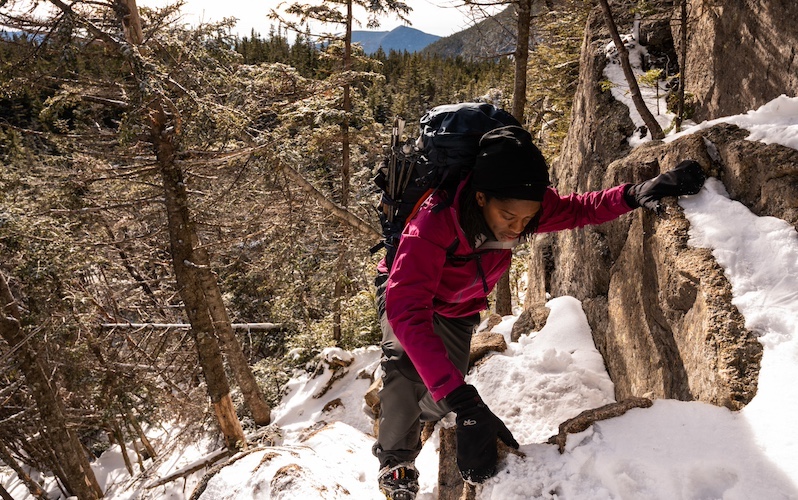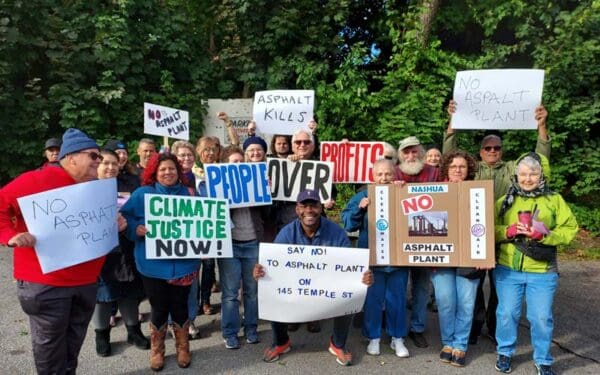
Mardi Fuller scales New Hampshire's Mt. Osceola. She says historic racism dissuades many Blacks from enjoying the great outdoors. Photo: Joe Klementovich
Outdoorswoman Mardi Fuller has reveled in nature all her life – hiking, backpacking, paddling, and more. In fact, the mountaineer, who enjoys hiking, backcountry skiing, and ice climbing, has earned a rare distinction: In January 2021, she became the first Black person to hike all 48 of New Hampshire’s 4,000-foot peaks in winter.
“Maybe 1,000 people have finished officially and submitted it to the Appalachian Mountain Club,” she estimates. “I didn’t particularly care about being on the list until I realized there were no Black people on it.”
And there’s a reason for that, says Fuller. Historic discrimination has conspired to deprive Black people of a full relationship with the outdoors.
Fuller, a Boston resident and advocate for racial equity in nature, recently visited CLF’s Boston office, where she spoke about discrimination and exclusion in natural spaces.
Below, we’ve adapted her remarks into an abridged Q and A.
CLF: According to the Outdoor Foundation’s 2022 Outdoor Participation Trends Report, less than 40% of Black people participate in outdoor activities – the lowest participation rate of any racial or ethnic group. Why do you think that is?
Fuller: My argument is that this is not due to a lack of interest but rather due to exclusion that has deep roots. The history maps out a story of systemic racial disparity.
CLF: You argue that nature and environmentalism are associated with “whiteness,” a term referring to beliefs that uphold white supremacy and make assumptions about who “belongs” outdoors. How do you define “white environmental ideology” in that context?
Fuller: American ideas of what nature is, as well as ideas of preservation and conservation, were shaped alongside the original U.S. nation-building project, which was predicated on slavery and dispossession, the genocide of Indigenous nations, enslavement of Black people, and the creation of a new identity for this land that we now call the U.S. And Black, Indigenous, Asian, Latinx, Middle Eastern, multiracial, and biracial people were not included in the narrative of who constitutes the citizenry of the U.S. We weren’t included when those same white men created narratives around our natural spaces. So, the current mainstream concept of nature is based on the white colonial imagination.
CLF: Part of the “white colonial imagination” you refer to is the concept of Manifest Destiny, an idea popularized in 1845 that suggested that God ordained the United States (defined as European settlers at the time) to expand its dominion over the entire North American continent. This was without regard for the Indigenous populations already here. You mention a painting by John Gast entitled “American Progress” to illustrate this idea.
Fuller: [The painting] is this allegorical representation of Columbia, this figure stringing a telegraph wire, holding a book, and bringing light to the darkness. And you see Indigenous people being forcibly removed under her and settlers coming in. This is the creation of the West and the creation of a lot of the mythology of our country.
It was during this time in history that the language that we use in our nature discourse was very purposefully formed. Words like “wild,” “untamed,” “empty,” “untouched,” “pristine.” [The language] was constructed in service of a myth that implicitly declared that this new land was ready to be filled with white male storytelling.
The last time you went out West, you probably said something about “wide-open spaces.” That’s a term that comes from this movement of westward expansion. Because we know that native people built roads and systems of agriculture, managed forests with controlled burns, and created infrastructure that was fully operational when settler colonists arrived. Many roads and trails today follow these ancient paths, even though we’ve attempted to erase their origin.
CLF: You quote from Carolyn Finney’s book, “Black Faces, White Spaces,” which explains that this country was founded with the rhetoric of wilderness, conquest, romanticism, transcendentalism, and the belief that humans can either control or destroy nature with technology. In that way, “wilderness” became linked to Eurocentrism and whiteness. Can you explain how this underlying attitude took concrete shape?
Fuller: As Finney lays out in her scholarship, many laws and practices codified this relationship. For example, while [forester and politician] Gifford Pinchot and [mountaineer and conservationist] John Muir were, on behalf of the federal government, developing and operationalizing their conservation and preservation strategies, the same federal government was putting laws into place to limit movement across the land and accessibility to the land for Black people, for Native people, of course, and for Chinese people as well.
The Homestead Act of 1862 allowed U.S. citizens to claim native land out West, around 160 acres for each claim. In 1862, Black people could not claim any of the land because they were enslaved and were not legal citizens. The Homestead Act ultimately transferred 10% of all land in the country to private owners. This went disproportionately to white people due to the initial exclusion of non-citizens and then because of racist practices and the distribution of the land. While white people were benefiting from the Homestead Act, the movement to give formerly enslaved people 40 acres and a mule was rescinded by the government to appease southern slaveholders after the Civil War.
When we’re able to deconstruct and examine white environmental ideology, we’re better able to see the way that the nation’s founders trained us to think of nature and who got to occupy it. We begin to see that Black people and people of color have never had freedom of movement on the land. Naming these helps us understand how white supremacy impacts Black participation rates in the outdoors.
CLF: What about today’s environmental messaging doesn’t ring true for many Black people?
Fuller: Assumptions like nature is a peaceful place where you can feel comfortable, where you can explore wild, open, untrampled backcountry, where you are free to operate as you please within regulation, but without scrutiny. There’s so much in the messaging that is linked back to white environmental ideology and experiences that many people of color would not experience as truths.
Black people have a traumatized relationship with the natural world due to being forced to work the land during the era of slavery and sharecropping. We have the memory of white terrorism and targeting, which could unfold in the woods where you could be assaulted or murdered. Lynchings happened in the woods. Black people could even be falsely accused, which would be enough reason to perhaps not want to be alone in a place where you could come across a hostile landowner.
CLF: In addition, Jim Crow laws and de facto segregation historically banned Blacks from public parks, beaches, and swimming pools.
Fuller: The egregious drowning disparity rates in the U.S. are a direct result. Black youth between the ages of 10 and 14 drown in swimming pools at 7.6 times the rate of white youth in the same age range. This is all directly related to the continued lack of access to pools and beaches.
CLF: So, what would a more inclusive outdoor culture look like?
Fuller: It needs to be centered around Indigenous sovereignty, climate change adaptation, environmental justice, equitable access to participation in nature, environmental protection, and sharing stories from marginalized groups. Central to all of it is that leadership and culture-building need to be led by people of color and LGBTQ folks, plus folks who live with disabilities or any underrepresented population that has not had the chance to lead. They need to be the ones doing the leading for at least a good while, and then I believe we’ll see some change.
You can follow Mardi Fuller on Instagram @wherelocsflyfree and on X @MardiFuller. Watch the short film by Paula Champagne: Mardi and the Whites




